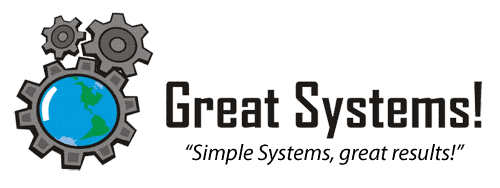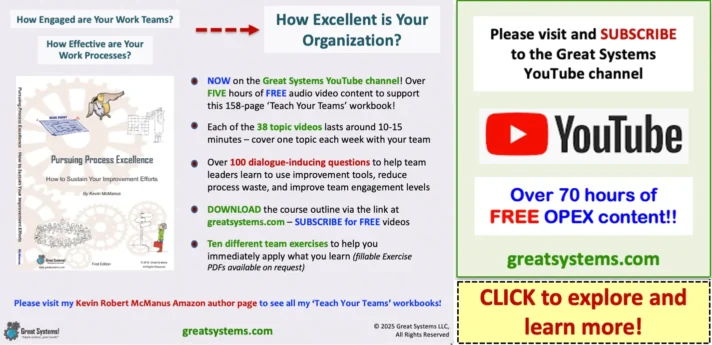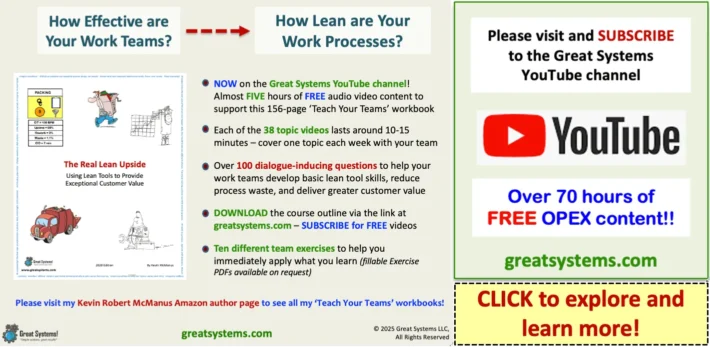Teach Your Teams Continuous Improvement Workbooks
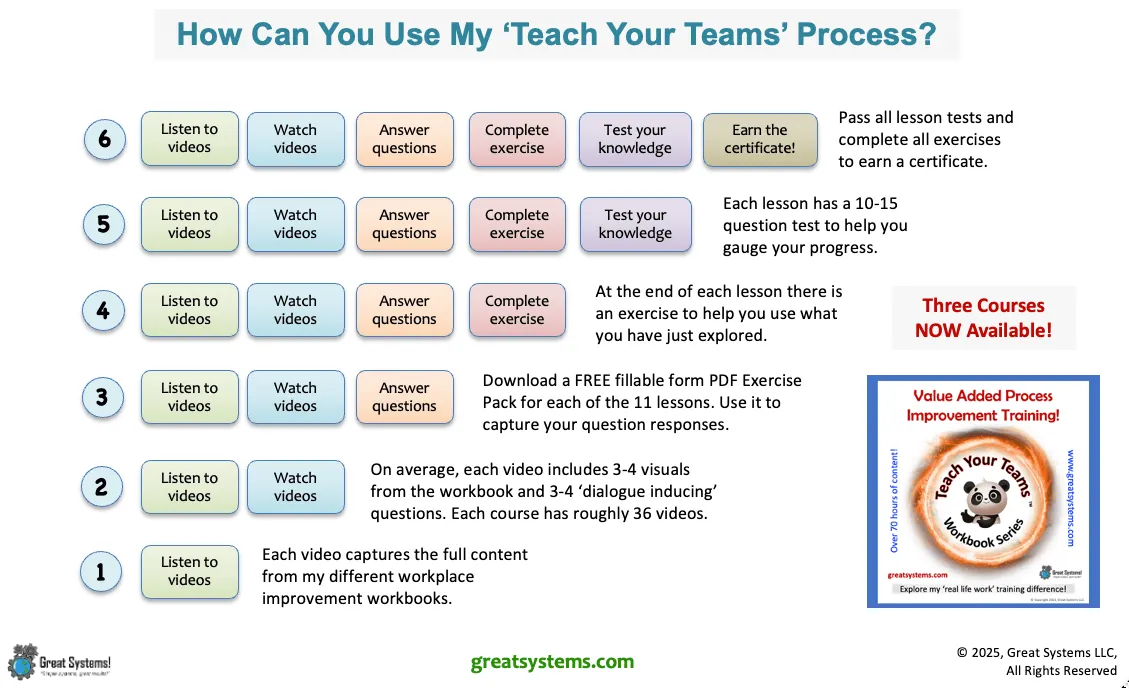
Teach Your Teams Continuous Improvement Workbooks
Each of my 'Teach Your Teams' continuous improvement workbooks began as a tool to help myself or others I knew through work. Today, my goal is to help trainers and leaders learn and teach others about high performance workplace best practices.
Please email me at kevin@greatsystems.com if you have a specific tool or challenge in mind. I have many more resources than I post at any given time.
Please email me at kevin@greatsystems.com if you have a specific tool or challenge in mind. I have many more resources than I post at any given time.
How to Use My ‘Teach Your Teams’ Continuous Improvement Workbooks
I design my continuous improvement workbooks as training tools others can use in their own organizations. Currently, my Great Systems YouTube channel has free video and audio content to support the three workbooks I describe below. Over 100 videos are available!
Plus, fillable PDF download exercise packs are available upon request. Just email me at kevin@greatsystems.com.
For more support, I offer virtual, live workshops. In these half-day workshops, I provide an overview of how I typically teach the 'Teach Your Teams' course. Plus, I model some of the key exercises to help you prepare to teach your teams yourself.
Just let me know if you have such an interest. I add video and audio content regularly, and my goal is to have more workbooks on-line by the end of 2025.
Multiple Sources and Formats to Teach Continuous Improvement Yourself
Each workbook is available on the amazon.com website in paperback and eBook formats. You can follow this link to my Amazon Author page.
My Author page is the easiest way to see all my kaizen and operational excellence content in one place. Follow the links to learn more about each workbook.
Plus, fillable PDF download exercise packs are available upon request. Just email me at kevin@greatsystems.com.
For more support, I offer virtual, live workshops. In these half-day workshops, I provide an overview of how I typically teach the 'Teach Your Teams' course. Plus, I model some of the key exercises to help you prepare to teach your teams yourself.
Just let me know if you have such an interest. I add video and audio content regularly, and my goal is to have more workbooks on-line by the end of 2025.
Multiple Sources and Formats to Teach Continuous Improvement Yourself
Each workbook is available on the amazon.com website in paperback and eBook formats. You can follow this link to my Amazon Author page.
My Author page is the easiest way to see all my kaizen and operational excellence content in one place. Follow the links to learn more about each workbook.
Facilitating and Leading Teams Workbook
Some say effective team facilitation is a lost art. How effective are your work team meetings? How many project and focus work teams do you need to have? Do your work team leaders lead meaningful meetings and facilitate effective group decision making?
Do you effectively use your meeting time? How often do you find your group going off on tangents or arguing about opinions instead of facts? Do one or two team members talk more than they should?
My 182-page, full color 'Facilitating and Leading Teams' kaizen training workbook helps you answer these questions. Also, it will help you address their related challenges.
Most organizations have too many teams in action. Plus, they waste time daily in too many wasteful meetings. All too often, leaders lack the facilitation skills to use necessary meeting time wisely.
The design of this 182-page, full color workbook helps any team leader (1) reduce meeting waste, (2) increase team effectiveness, (3) put more effective process improvements in place.
DOWNLOAD my 'Facilitating and Leading Teams' On-Demand Workshop Outline
WATCH video from my 'Facilitating and Leading Teams' YouTube playlist
BUY my digital or hard copy 'Facilitating and Leading Teams' workbook on amazon.com
Do you effectively use your meeting time? How often do you find your group going off on tangents or arguing about opinions instead of facts? Do one or two team members talk more than they should?
My 182-page, full color 'Facilitating and Leading Teams' kaizen training workbook helps you answer these questions. Also, it will help you address their related challenges.
Most organizations have too many teams in action. Plus, they waste time daily in too many wasteful meetings. All too often, leaders lack the facilitation skills to use necessary meeting time wisely.
The design of this 182-page, full color workbook helps any team leader (1) reduce meeting waste, (2) increase team effectiveness, (3) put more effective process improvements in place.
DOWNLOAD my 'Facilitating and Leading Teams' On-Demand Workshop Outline
WATCH video from my 'Facilitating and Leading Teams' YouTube playlist
BUY my digital or hard copy 'Facilitating and Leading Teams' workbook on amazon.com
What makes my 'Facilitating and Leading Teams' workbook different from the rest?
The main reason my 'Facilitating and Leading Teams' training workbook is different, and works, is that it is practice oriented. The team facilitation skills and tools you learn and practice help you waste less meeting time.
Well-facilitated virtual team events help you benefit more from the different perspectives on the team. You arrive at more effective solutions, in less time.
Less time is spent in formal meetings. Plus, you get better results from the meeting time you do invest. The key lies in leaders that practice the right facilitation skills at the right time and continue to practice in the spirit of improvement.
Plus, its content helps you optimize your mix of process teams, project, and focus work teams. Finally, the workbook gives you facilitation best practices and strategies to improve team support for the optimum mix of teams you need.
Well-facilitated virtual team events help you benefit more from the different perspectives on the team. You arrive at more effective solutions, in less time.
Less time is spent in formal meetings. Plus, you get better results from the meeting time you do invest. The key lies in leaders that practice the right facilitation skills at the right time and continue to practice in the spirit of improvement.
Plus, its content helps you optimize your mix of process teams, project, and focus work teams. Finally, the workbook gives you facilitation best practices and strategies to improve team support for the optimum mix of teams you need.
Pursuing Process Excellence Workbook
This 158-page, full color workbook is designed to help any organizational or site leader identify and address work system design constraints that hold back their pursuit of operational excellence.
For example, in many organizations, few employees can use process improvement tools themselves. Also, many work team leaders are not responsible for consistent process improvement.
Worst of all, we fail to engage a high percentage of our workforce in our operational excellence pursuit. Ironically, the systems to achieve such high engagement are not very costly or challenging to implement.
DOWNLOAD my 'Pursuing Process Excellence' On-Demand Workshop Outline
WATCH videos from my ‘Pursuing Process Excellence’ YouTube playlist
BUY my digital or hard copy ‘Pursuing Process Excellence‘ workbook on amazon.com
For example, in many organizations, few employees can use process improvement tools themselves. Also, many work team leaders are not responsible for consistent process improvement.
Worst of all, we fail to engage a high percentage of our workforce in our operational excellence pursuit. Ironically, the systems to achieve such high engagement are not very costly or challenging to implement.
DOWNLOAD my 'Pursuing Process Excellence' On-Demand Workshop Outline
WATCH videos from my ‘Pursuing Process Excellence’ YouTube playlist
BUY my digital or hard copy ‘Pursuing Process Excellence‘ workbook on amazon.com
How can my 'Pursuing Process Excellence' continuous improvement workbook make your job easier?
Too many organizations rely solely on kaizen teams, six sigma teams, or their process engineers as they attempt to pursue operational excellence. Do you want to accelerate and sustain your site or organizational pursuit of operational excellence? If so, you must address those systematic constraints that hold back your current improvement efforts.
Project teams alone take too long. I wrote this workbook to help leaders install work systems that engage a high percentage of the workforce. Also, a high percentage of the organization's key work processes need renovation via a systematic and consistent formal process improvement effort.
Perhaps most importantly, my workbook's design helps you find time for improvement. The 'Pursuing Process Excellence' workbook's 10 exercises help you create a plan for effective work time use. This plan helps you begin your transition from reactive problem solving to proactive daily kaizen!!
Project teams alone take too long. I wrote this workbook to help leaders install work systems that engage a high percentage of the workforce. Also, a high percentage of the organization's key work processes need renovation via a systematic and consistent formal process improvement effort.
Perhaps most importantly, my workbook's design helps you find time for improvement. The 'Pursuing Process Excellence' workbook's 10 exercises help you create a plan for effective work time use. This plan helps you begin your transition from reactive problem solving to proactive daily kaizen!!
The Basics of Lean Tool Use Workbook
My 156-page, full-color ‘Basics of Lean Tool Use' workbook covers the basic skills and approaches you need to create value stream maps and spaghetti diagrams, perform quick changeover analysis, put in place a visual workplace, and install 5S work practices.
If you want to make lean thinking a daily habit across your organization, or simply within your own work team, you can use this workbook to conduct your own highly interactive workshop.
DOWNLOAD my ’Basics of Lean Tool Use’ On-Demand Workshop Outline
WATCH video from my ’Basics of Lean Tool Use‘ YouTube playlist
BUY the digital or hard copy ‘Basics of Lean Tool Use’ workbook on amazon.com
If you want to make lean thinking a daily habit across your organization, or simply within your own work team, you can use this workbook to conduct your own highly interactive workshop.
DOWNLOAD my ’Basics of Lean Tool Use’ On-Demand Workshop Outline
WATCH video from my ’Basics of Lean Tool Use‘ YouTube playlist
BUY the digital or hard copy ‘Basics of Lean Tool Use’ workbook on amazon.com
How can this continuous improvement workbook help you make lean tool and concept use daily work habits?
The design of my “Basics of Lean Tool Use" workbook can help anyone who wants to reduce waste and increase customer value for those key processes they own. Plus, the lean tools you learn to use, and the exercises you experience, give you better lean implementation results in less time and at a lower cost.
Two assessments in the workbook help you gauge the degree of support your lean efforts require. Also, they help you gauge your lean transition progress.
Plus, this workbook focuses on the types of changes one needs to make if they want every team member to make lean tool use a daily work habit. Thirteen exercises are included to help you and your work team practice the use of five key lean tools, create a lean work culture, and plan for future lean success.
Two assessments in the workbook help you gauge the degree of support your lean efforts require. Also, they help you gauge your lean transition progress.
Plus, this workbook focuses on the types of changes one needs to make if they want every team member to make lean tool use a daily work habit. Thirteen exercises are included to help you and your work team practice the use of five key lean tools, create a lean work culture, and plan for future lean success.
LISTEN NOW to my ''Measuring Training Effectiveness" Real Life Work podcast
My First Three Teach Your Teams Courses are Now Available
A complete set of 'Teach Your Teams' video and audio content is NOW available for my first three Kaizen Learning Universe courses on my Great Systems YouTube channel.
My 'Basics of Lean Tool Use' course focuses on how to make kaizen a daily work habit. My 'Pursuing Process Excellence' course contains a variety of exercises to help leaders move closer towards their operational excellence goals. Finally, my 'Facilitating and Leading Teams' course helps leaders at levels learn how to effectively facilitate and lead work teams.
Also, I will soon offer this content as part of the different courses in the Great Systems Kaizen Learning Universe. Class for beta customers opens in mid-2025.
Download options will include PDF, mp3, and mp4 content to support each of the six different 'Teach Your Teams' (TYT) kaizen and continuous improvement workbooks. Stay in touch to learn more about the workbooks and process.
My 'Basics of Lean Tool Use' course focuses on how to make kaizen a daily work habit. My 'Pursuing Process Excellence' course contains a variety of exercises to help leaders move closer towards their operational excellence goals. Finally, my 'Facilitating and Leading Teams' course helps leaders at levels learn how to effectively facilitate and lead work teams.
Also, I will soon offer this content as part of the different courses in the Great Systems Kaizen Learning Universe. Class for beta customers opens in mid-2025.
Download options will include PDF, mp3, and mp4 content to support each of the six different 'Teach Your Teams' (TYT) kaizen and continuous improvement workbooks. Stay in touch to learn more about the workbooks and process.
